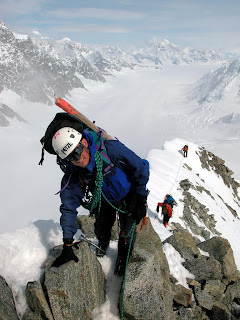

At the time when the initial plan for this expedition took shape, I’d been mountaineering in assorted locations around the world for quite a few years. I’d also been living in Vancouver, British Columbia for several years and had been taking advantage of the amazing local mountains for weekend climbing trips. Like most weekend outdoors people, I had dreams of heading off on other bigger trips to climb any number of the more significant peaks in the world.
One of these “objects of my desire” was to climb Canada’s highest mountain – Mt Logan. Mt Logan is pretty much 6000m high (technically just a couple of meters less I think) and is located in a very inaccessible region of North America. Specifically it is very close to the US boarder with Alaska, and very near the Pacific coast. There are absolutely no roads in the area and the mountains and glaciers are the largest and most formidable in North America (there are several other very large mountains of “ill repute” in the immediate area).
Now, the problem with these kinds of mountaineering trips are that they are not for “the faint of heart”, and they are not accomplished in a weekend or without spending quite a bit of money and a good amount of effort on planning and preparing. The usual problem for me though is finding people that I would be willing to undertake the trip with. People with the time, money, and skills for such an expedition are few and far between. Even with those basic issues sorted out, there are few people I am prepared to tie myself to a rope with and trust them with my life “when the chips are down” or alternately, spend a week stuck in an Arctic storm in a tiny tent on an extreme mountain ridge for a week with! – Personality and character are also critical issues!
Mt Logan has at least a half a dozen different routes of ascent and by far the most popular route is “The Kings Trench” which is long and not very technical (3000m vertical rise, 25km in length). Its basically a very long trudge to high altitude on skis. Then there are a couple of more technical routes that get climbed regularly including “The East Ridge” (3600m vertical rise, 10km in length?), and "Hubsew Ridge”. Other routes are far more difficult and infrequently climbed including the infamous “Humming Bird Ridge” (4000m vertical rise, 15km in length?), that was only ever climbed once and people have disappeared trying to repeat the route!
The thing about a 6000m high mountain located in sub-Arctic latitudes is that no matter what route you choose, even if you take the easiest option and manage to get to the summit, you’ve managed a very significant achievement. That said, I was not happy just doing the Kings Trench route and I wanted to do something more technical – The most probable route in my mind was the East Ridge but I was prepared to be flexible for others on any possible team. However this intent to climb a technical route of course meant that it was even harder for me to find suitable people to attempt the climb with.


































